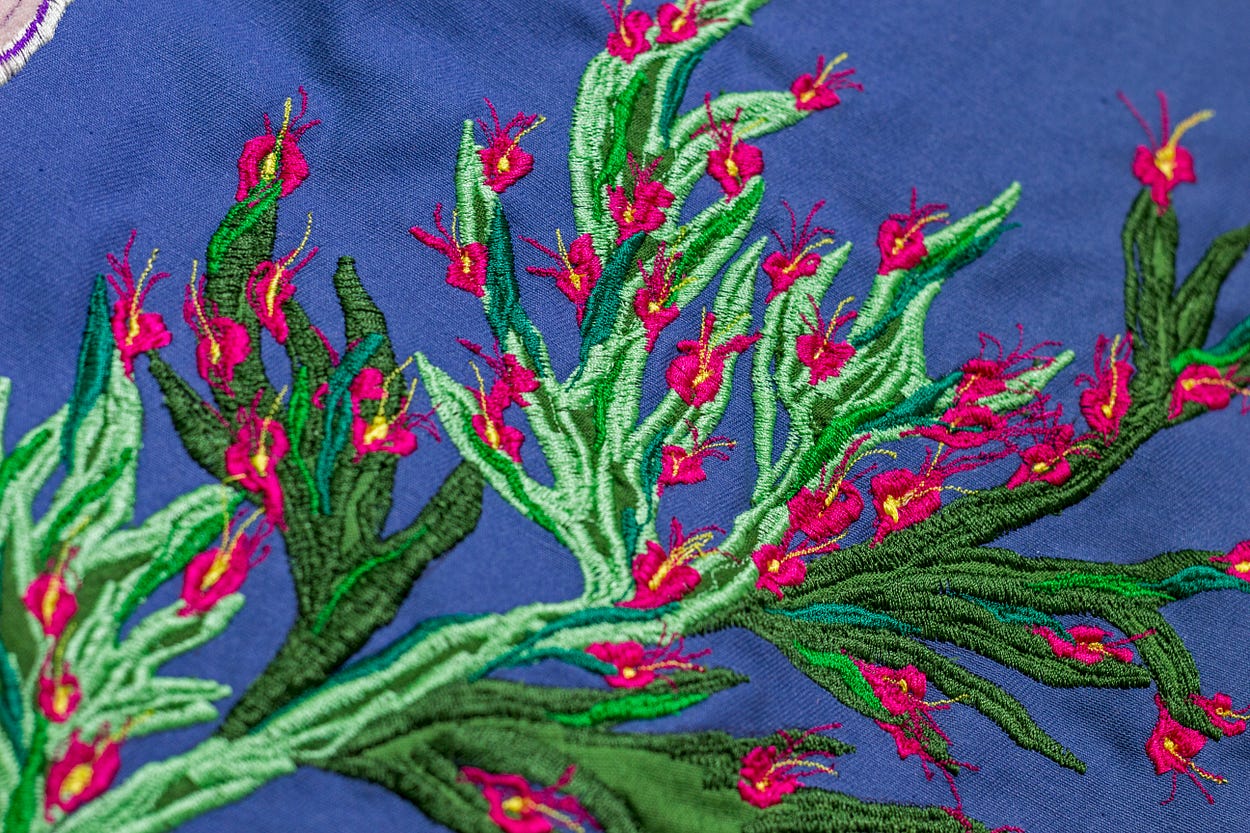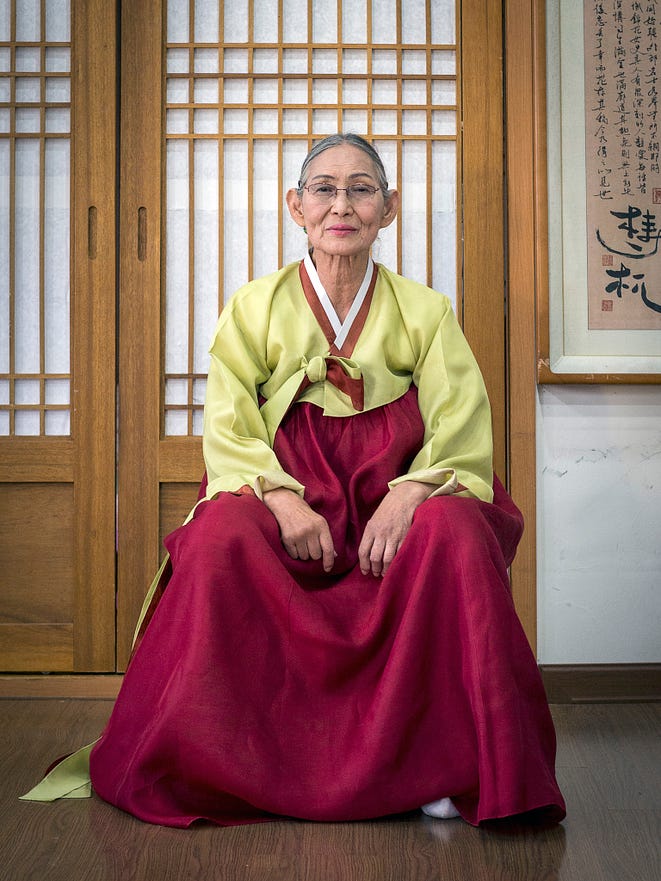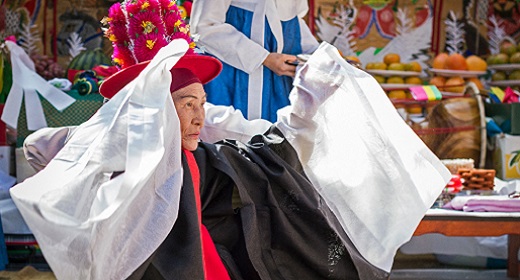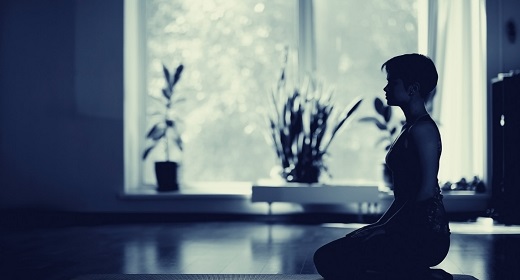by Karen Eng: Artist Jorge Mañes Rubio travels to Seoul, Korea, to learn about the city’s primarily female shamans and their vital role in contemporary urban life…
In cultures all over the world, the figure of the shaman stands out as the one who bridges the mortal and spirit worlds. Often living at the edges of society but functioning at its center, shamans were entrusted with the ability to communicate with nature spirits, ancestors or a culture’s gods and goddesses — and could function variously as oracle, doctor, psychotherapist and beyond.
Such practices have ancient roots, but — as artist and Jorge Mañes Rubiodiscovered — shamanic traditions are still very much alive and relevant today. Here, Mañes Rubio, a TED Fellow, describes what he experienced when he entered the world of contemporary Korean shamanism during a 2017 residency at Seoul’s National Museum of Modern and Contemporary Art, and offers his take on how it relates to humanity’s relationship to art and spirituality.
What did you understand shamanism to be before you went to Korea? How did that compare to what you actually found?
My idea of shamanism going into this project was very much a Western perspective: I thought a shaman would live in a remote place, maybe a jungle in Brazil, or in West Africa. I also associated shamans with people who ingest substances to send their souls into other worlds to retrieve knowledge.
Korean shamanism works the opposite way. The spirit of the shaman—known in Korea as manshin—does not travel somewhere else. Instead gods, spirits or ancestors descend into the shaman, so that the shaman becomes a god herself. It’s a very powerful thing to witness: the possessed shaman talks and moves completely differently, she presents completely different personalities — sometimes speaking in regional dialects that the shaman herself does not know how to speak — and assumes a position of authority. People acknowledge the god’s presence with particular hand gestures and a bow — this means you recognize that the shaman’s not a shaman anymore, she’s a god.

Why do people go to shamans?
You can consult a shaman for any reason — whether moving to a new house, buying a new car, to help your business, to make sense of your son or daughter, or something heavier. If a person is going through a particularly bad illness, for example, a shaman might conclude that an evil spirit or restless ancestor is interfering and an exorcism is needed. I never witnessed an exorcism, but I did see, for example, a ritual organized for the parents of a client who was worried that they weren’t happy at the end of their lives.
When it comes to health issues, a shaman may confer a healing, but will not claim to be a substitute for Western medicine. If someone is very sick, and the shaman sees it, she will do a ritual but urge the person to visit a hospital, perhaps acting as an oracle and recommending a time or particular establishment.
Where do Korea’s shamans operate? Are there temples? Do they mainly practice in remote areas, as you thought?
My prejudices told me that shamanism and urbanism don’t really go together, but I learned that in Korea, they definitely do. Seoul has Korea’s biggest concentration of shamans. It used to be a rural practice, and of course there are different styles spread all over Korea — including North Korea — but the shamans go where the clients are.
For example, once a fire broke out in the middle of some new construction at the National Museum of Modern and Contemporary Art, so before continuing, they called shaman Kim Keum-Hwa to cleanse the place, to ensure the rest of construction would go well. So while people might hold prejudice towards shamanic practice, the truth is that shamans are still relied upon in 21st-century Seoul to play a role in society.
There are shamanic temples dotted around Seoul — maybe one or two. But most of the time, they operate out of commercial temples called gutdang. A shaman will rent a room for the day, and customers meet her there to carry out the ritual. There could be five rituals going at the same time in this building.
What does a typical ritual look like?
Rituals are collective endeavors that link shaman, client and the spirit world. Each shaman typically acts out of their own space, which is decorated with statues of gods. It’s a bit like a doctor’s office. Often people make short visits, using the shaman occasionally as a fortune-telling consultancy. Only when the shaman diagnoses a more serious problem does she embark on a longer, more elaborate ritual. A full ritual is the very last resort for solving any problem.
A whole team helps the shaman perform her ritual. They’ll play musical instruments key to helping the shaman make contact with the supernatural world — the most important being the hourglass drum and cymbal, but also gongs, rattle bells and flutes. Different sounds accompany the shaman throughout the ritual: loud, upbeat entrancing rhythms feature in the most dramatic moments, which can last for several minutes. Spirit daughters form part of the team: they’re young apprentices who are being trained and are learning the chants and different segments of a ritual.
Depending on the importance of the ritual and the gods being summoned, several offerings are made: usually fruits, rice cakes, dried fish and alcoholic drinks such as soju and makgeolli. On very special occasions, even entire pigs and cows are offered.
Shamans also use knives to assert their authority and power, stepping on their sharp blades at the end of a ritual. The shaman sharpens the blades right in front of you, and she’ll cut some clothes or vegetables to prove how sharp they are. The shaman will step and even jump on them for several minutes, but she won’t bleed or get hurt. It’s unbelievable unless you see it.

That sounds terrifying.
It is. Once I witnessed a shaman—actually the sweetest, most beautiful and kind lady—get possessed by a terrifying god. Suddenly she was brandishing knives, shouting and demanding that all of us should bow to him—including me. I wasn’t sure what to do, but everyone looked at me as if to say, “Dude, you’re part of this now! Bow like everyone else!” So I did.
Afterwards, the shaman apologized. She said, “I always try to refuse this god, because I know he’s very mean, and he’s very powerful. I always try to tell him, ‘No, no, no.’ But this time I couldn’t. I’m so sorry.”
How do the gods interact with the supplicant?
Gods are very temperamental. Sometimes they get jealous. And they always complain. I once saw a female god who descended and started complaining that the costume the shaman was wearing—which represented the god herself—wasn’t good enough. So always, there’s negotiation. “These offerings are not enough,” says the god through the shaman to the client. “You haven’t done enough. This fruit is not enough, the meat and the two pigs and the entire cow — I’m very hungry, it’s not enough.” One female god said, “Look at this painting of me, and look at the costume I’m wearing. The painting is beautiful, but this clothing is not good enough.”
Gods often demand prayer: “You didn’t pray for me enough.” Ancestors say “You didn’t think about me; you didn’t give me my favorite liquor or my favorite food.” Or, if it’s a children’s god, “I didn’t get enough candy.”
The supplicant then says, “I’ll do better. I’ll get you a better costume; I’ll pray more for you. I’m going to bring you more wine.” In the end, the god finally agrees to help the supplicant. But there’s always a ping-pong table of negotiations.


Manshin Kim Nam-Sum as Seon-Wangsin, the Late King God, opening the four directions to invite the gods into a ritual near Kookmin University, Seoul. Right: Colourful paper lanterns made by the artist’s friend Jo, hanging at Kim Keum-Hwa’s shrine in Ganghwado.



How is one called to become a shaman in Korean culture? Is it a vocation open to anyone?
Most shamans from the north of the Han River perform in Hwanghae-do style — named after a former joint North and South Korean province — and are called into the profession by spirit sickness. First they get very ill, and once they finally realize that this is a call to become a shaman, they accept their gods and do an initiation ritual. In many cultures around the world, this is a classic call to shamanic practice. This is the type of shamanic practice where shamans get possessed by otherworldly beings.
In the southern part of Korea, mostly south of the Han River, the calling is mostly hereditary. You might learn the profession from your parents, or from your grandmother, or from an uncle. These shamans do rituals, but they do not get possessed by gods or spirits. So there can be a vast difference in shamanic style.
Are people in contemporary Korea aware that these traditions are still happening? What kind of place does shamanism hold in current culture?
Everybody in the culture knows what shamans are. They may deny this knowledge, yet privately still visit shamans to attend to particular needs. Shamanism is not an organized religion per se, and some view it as “primitive,” so a lot of people don’t take it seriously in Korea. But to me, the lack of hierarchy makes it even more legitimate. I think most people worldwide, especially younger generations, have very little interest in religion because of its associations with power, repression and so on. But shamanism doesn’t care about that. A good shaman welcomes people who want to learn or know more about them, but has no interest in forcing their practices onto others, or using their abilities to influence others.
One thing that makes Korean shamanism unique is that most of Korea’s shamans are women — around 90%, 95% percent. In contrast, most rituals in Korea to honor ancestors are exclusively performed by men under rigid Confucian frameworks. Like many cultures, Korean culture is quite patriarchal, and shamanism represents one place where women hold a position of power.
This may be related to women and social class, but traditionally in Korea, shamans were always at the bottom of the social pyramid. Now, in modern times, many are successful and maintain a higher profile. Shamans are people who hold degrees, who have an internet presence on Facebook and YouTube. They write blogs.


Manshin Kim Keum-Hwa carries out a ritual at her shrine in Ganghwado, South Korea. Right: Making the Invisible Visible, pigments on paper. 280x110x70cm.
How has this form of shamanism evolved with time — are shamans expected to follow strict traditions in order to be authentic? Do shamans view themselves as guardians of past traditions?
It depends on perspective. From an academic point of view, shamanism is being celebrated, even protected, in Korea. Meanwhile, some shamans are regarded as cultural treasures, and scholars and academics do care that they follow the traditions — that they sing the same songs they sang 300 years ago, that they follow the same rules. Shamans who are protected by the government, in particular, have to make sure to preserve and protect specific rituals.
However, most of the shamans I met don’t agree with only maintaining tradition. They say that every ritual should be different, and should be flexible and modified according to the needs of the client. I think they see their role as someone who establishes or restores balance to people’s lives.


Manshin Kim Keum-Hwa at her shrine in Ganghwado, South Korea. Right: Mediator #3, pigments on paper. 90x70cm.
What kind of art are you making in response to this experience?
I must admit my intentions changed during my stay in Korea. In the beginning, my goal was to be able to attend a few rituals and focus on a photographic project. But I struggled to portray all the emotions that overflow during the rituals, the music, the chanting, the movements. That’s when I started filming and recording and noticing some of the artifacts that were used during the rituals.
The real shift happened when I established a friendship with two people who took it upon themselves to teach and show me shamanism from a deeper perspective. They taught me the meanings behind each ritual segment or song, and showed me the more human side of the shaman — not only the exotic and powerful being, but also a calm, friendly, wise woman. I think it’s important that people see shamans this way too, as someone to trust and not to be afraid of.
I started asking these friends how to create certain objects used in shamanic ritual, mostly paper sculptures that are placed next to the offerings — beautifully described to me as “chairs for the gods.” These transform a common sheet of paper into a delicate and sculptural object. My friend Jo taught me how to dye, fold and cut paper, and showed me where to buy the materials I needed. Finally I decided to create my own interpretations of these objects — not as sacred object in themselves, but as a reminder of my experiences

What do you want people to take away from the exhibition of these artworks?
There are values in Korean shamanism we can absorb and apply: such as respect for ancestors, care for our indigenous beliefs, love and appreciation for nature and compassion. Shamanism is not linked with the elite, social classes or power. Likewise, I believe that true art comes from the bottom: not from those with wealth and power, but from those who seek deeply in their own souls and can represent the ideas and values they find within.
It isn’t fair that shamanism is relegated to the status of anachronism — a subject to be studied by anthropologists and displayed at ethnographic museums. Why is the art of European or American artists displayed in modern and contemporary art museums, while an amazing artwork from, say, Congo or Peru goes to a folk or ethnographic museum? This reductionist and colonial approach is still the framework we follow for how to value art today.
I’m challenging such prejudicial frameworks by choosing to exhibit these pieces in a traditional Western white cube gallery. Also, in my Temple of the Moon project with the European Space Agency, I’m envisioning sending objects and artifacts common to many civilizations across history — such as masks, talismans and so on, rather than, for example, a Picasso or Van Gogh — to our hypothetical temple for lunar settlers. Such objects are more universal to humanity as a whole and appeal to our deepest, most archetypal beliefs.
This project was supported by the National Museum of Modern and Contemporary Art, Korea and the Mondriaan Funds
















































